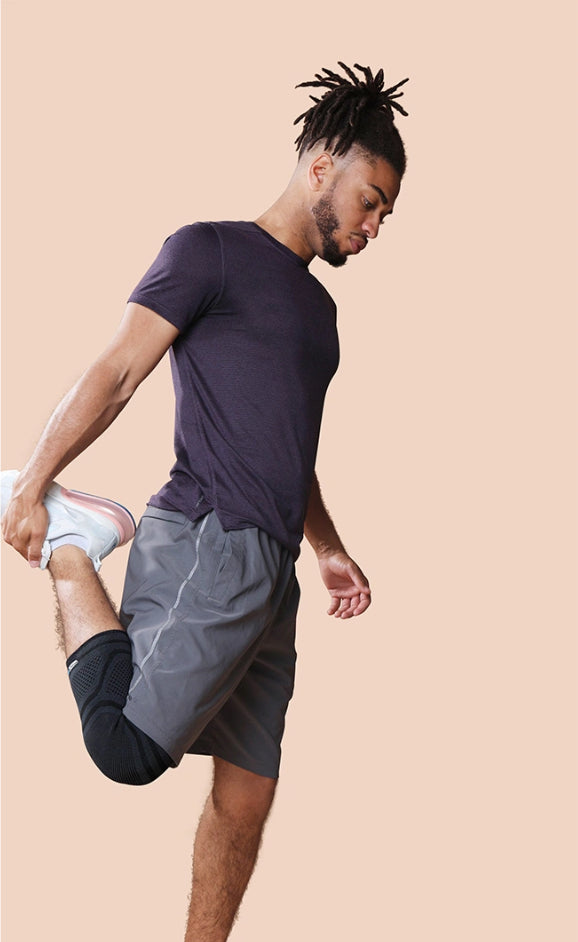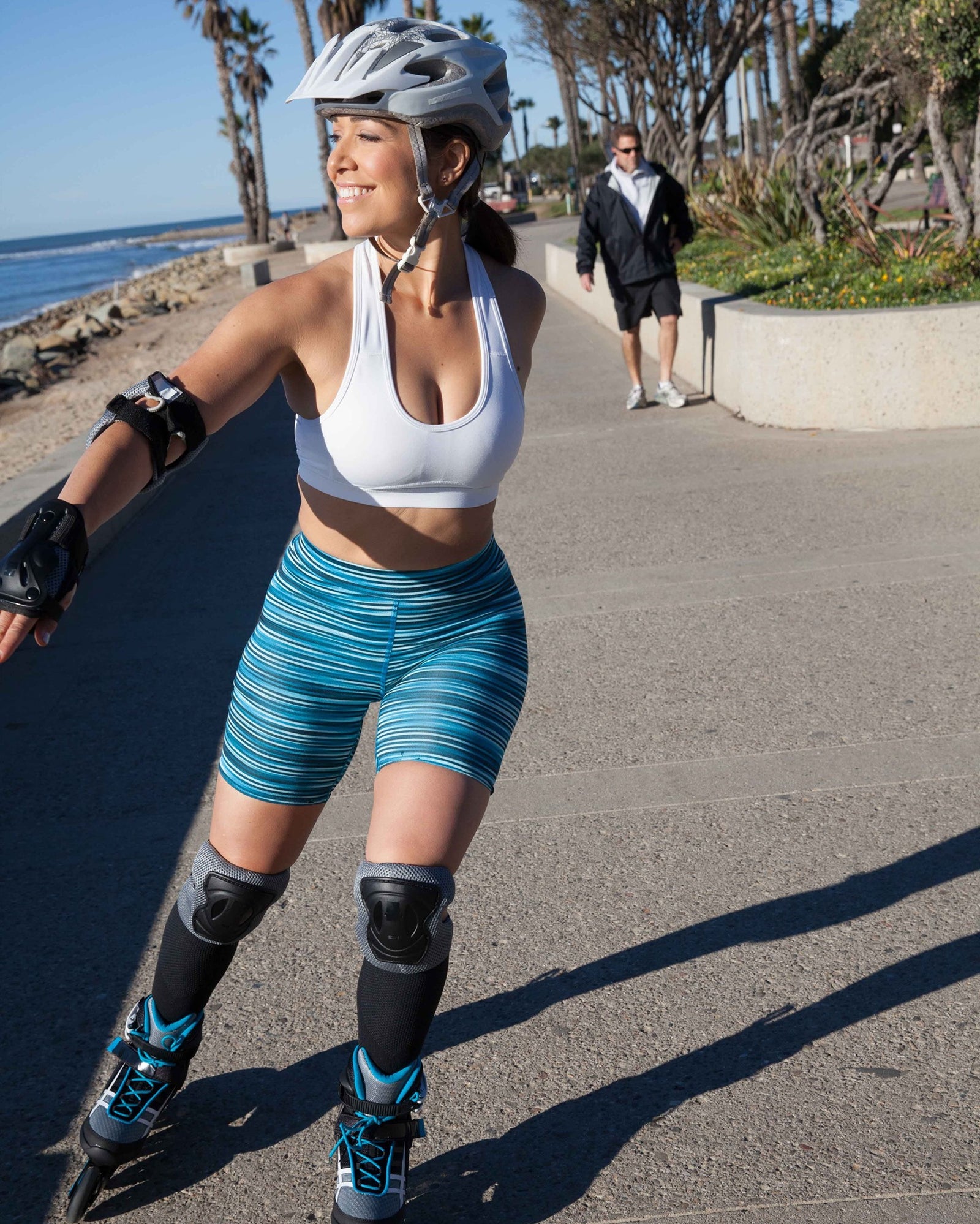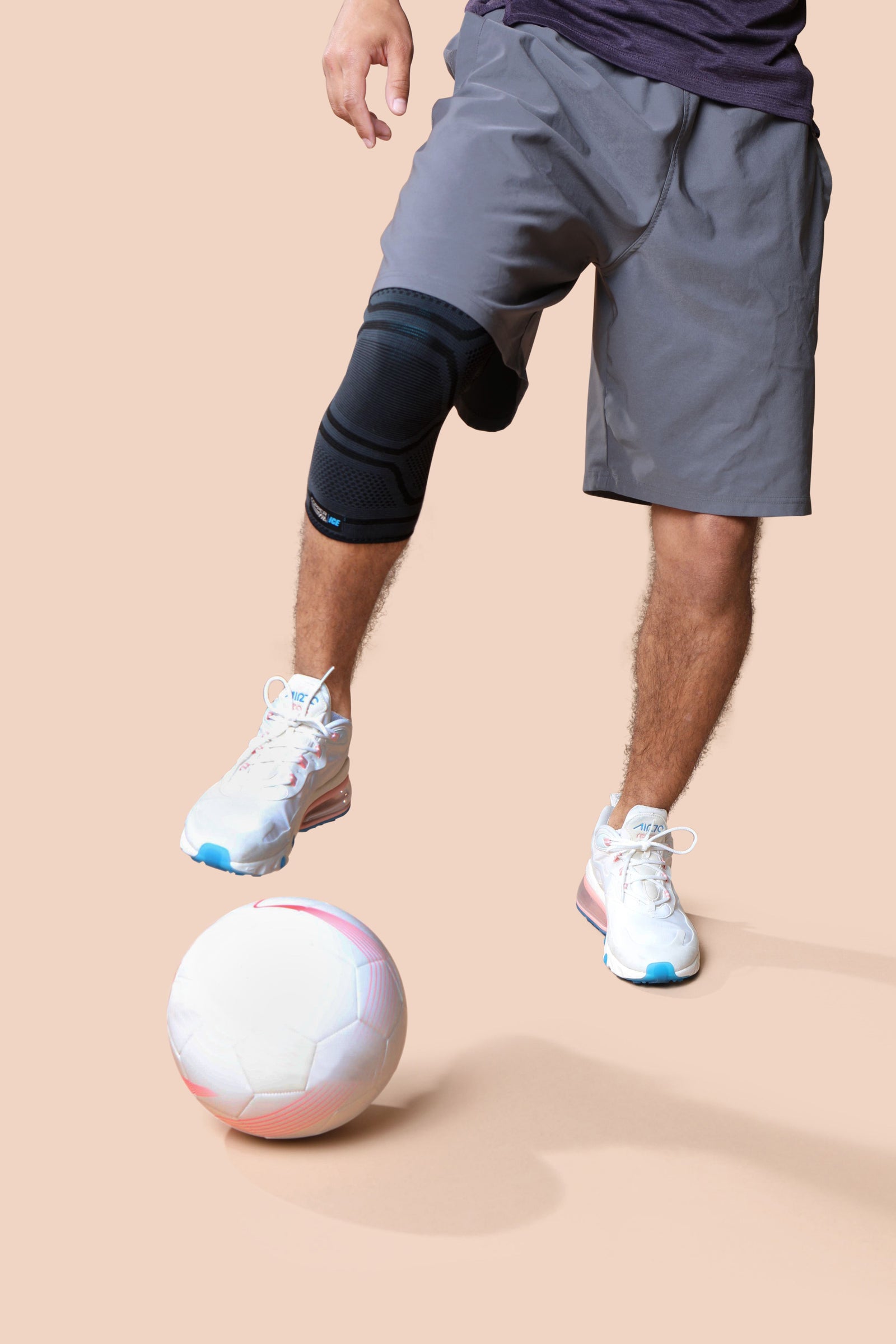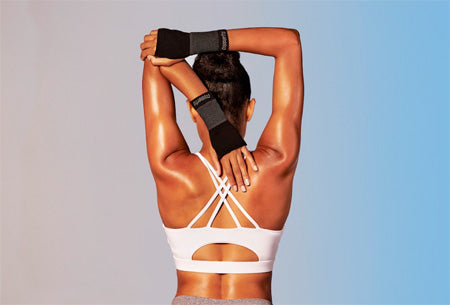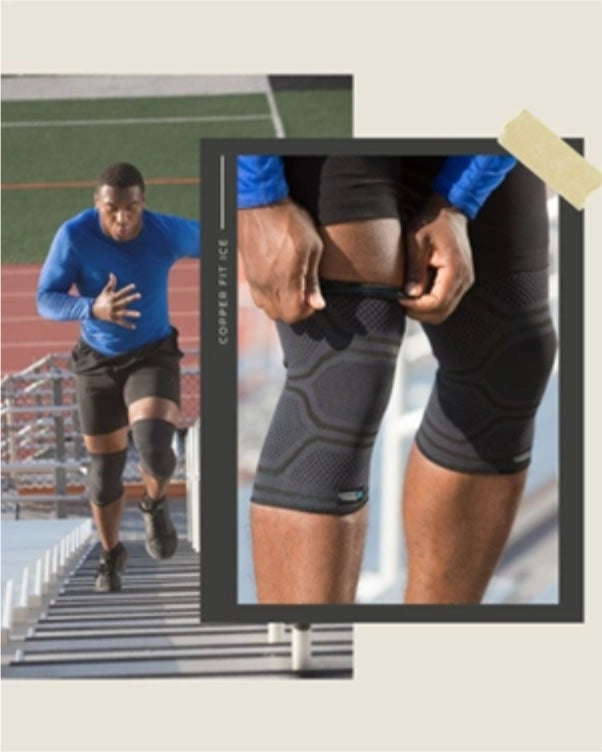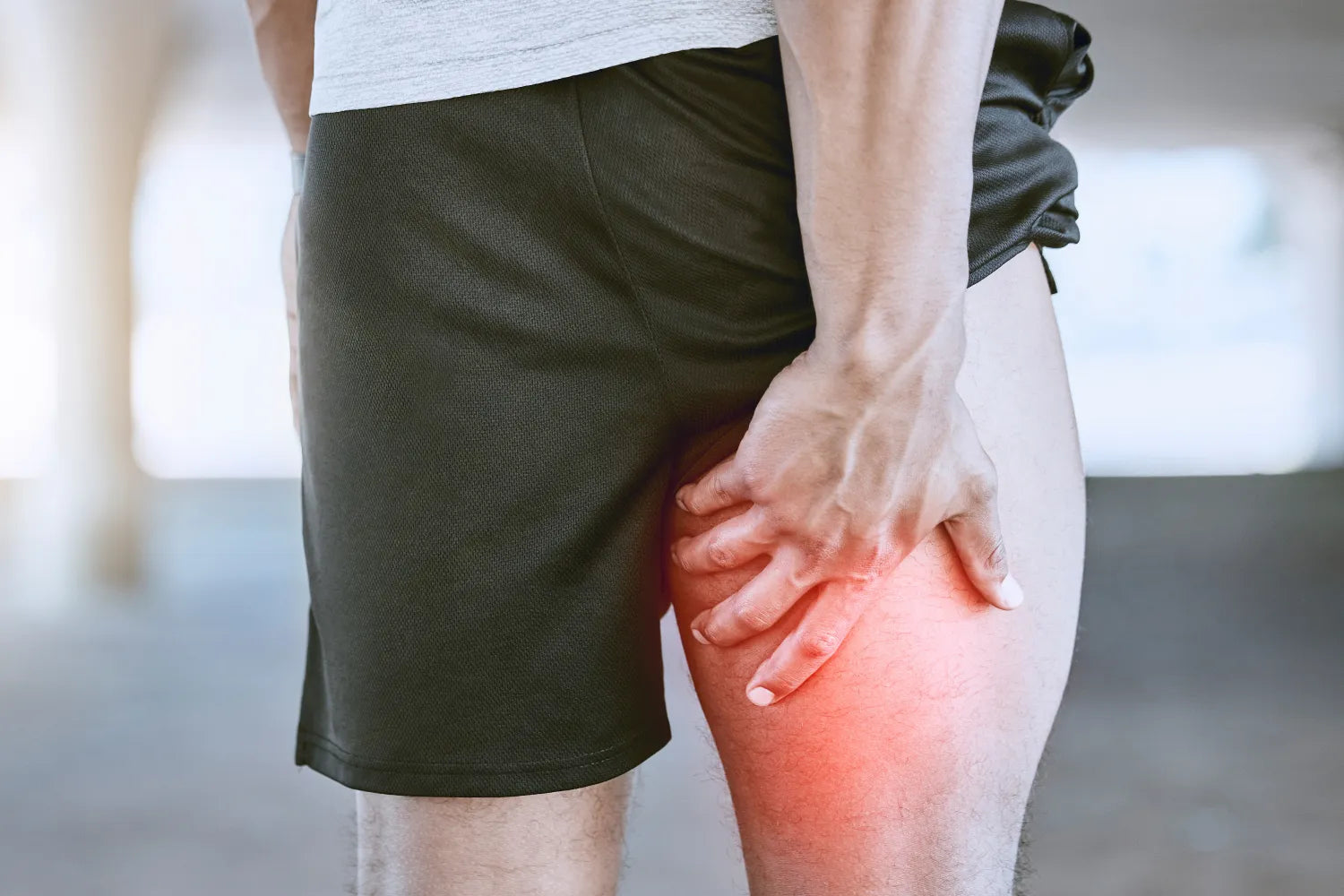
Key Takeaways
- A pulled hamstring often feels like a sudden tightness or sharp discomfort in the back of the thigh, followed by lingering soreness or limited range of motion.
- Most hamstring pulls are mild to moderate and respond well to rest, hydration, compression, and gradual movement.
- Prevention is possible through warming up, strengthening supporting muscles, and staying flexible to support recovery.
A pulled hamstring can happen in an instant. One step too fast, a skipped warm-up, or a quick change in direction, and suddenly, you feel it. That discomfort in the back of your thigh mid-stride, or a twinge when trying to walk after a workout.
Hamstring pulls are one of the most common muscle strains for active adults, especially in sports or activities that involve running, jumping, or bending at the hip. This guide breaks down exactly what a pulled hamstring feels like, why it happens, and what you can do to support your body through recovery and prevention.
Whether you're pushing for personal bests or just trying to stay active and mobile, learning how to manage and prevent hamstring pulls can keep you moving forward.
What Is the Hamstring?
The hamstring isn’t a single muscle. It’s actually a group of three muscles located at the back of your thigh: the biceps femoris, semitendinosus, and semimembranosus.
Together, these muscles work to bend your knee and extend your hip. They’re essential for walking, running, climbing stairs, squatting, and just about any movement that involves your legs.
Because these muscles span two major joints—the hip and the knee—they're under constant demand, especially during high-intensity or repetitive movements. That makes them more vulnerable to overstretching, especially if the muscle is tight, fatigued, or underprepared.
What Does a Pulled Hamstring Actually Feel Like?
A hamstring pull, also called a strain, is the result of overstretching or tearing some of the muscle fibers. The feeling can range from mildly uncomfortable to suddenly limiting, depending on the severity.
Here are a few common sensations associated with a pulled hamstring:
Sudden Sensation During Movement
Many people describe it as a sharp or snapping sensation in the back of the thigh. It’s not always intensely painful, but it can definitely stop you in your tracks. The leg might feel weak or like it’s giving out.
Soreness or Tightness That Lingers
After the initial pull, the area may feel tight, sore, or tender to the touch. Sitting or standing for long periods might make it worse. Some people also notice a deep ache that makes bending or straightening the leg uncomfortable.
Swelling or Muscle Tension
Depending on the severity, you might experience swelling, warmth, or stiffness in the area. You may not see visible bruising, but the muscle can feel harder or more swollen than usual.
Reduced Range of Motion
Stretching the hamstrings by bending forward or lifting your leg might feel limited or uncomfortable. You might notice a pulling sensation even during light activity, and it can feel like the muscle just won’t release.
Understanding Different Types of Hamstring Strains
Hamstring pulls are typically graded based on how much of the muscle is affected:
- Grade 1:A mild strain where the muscle is overstretched but not torn. You’ll likely feel tightness and some discomfort, but you can still move around with care.
- Grade 2:A moderate strain involving partial tearing of the muscle. This can make walking or bending the knee more difficult and uncomfortable.
- Grade 3:A more severe tear that usually limits movement significantly. While rare, this type may require professional evaluation and extended recovery time.
Most people dealing with a pulled hamstring are dealing with grade 1 or 2 strains, which are manageable with smart recovery habits and a bit of patience.
What Can Cause a Hamstring Pull?
Understanding what causes a pulled hamstring can help you take steps to prevent it from happening again.
Here are some of the most common causes:
Sudden Movements
Activities like sprinting, jumping, or lunging can cause a quick stretch beyond the muscle’s current capacity, especially if you weren’t fully warmed up or are working at high intensity.
Muscle Imbalances
If your glutes or core are underactive, your hamstrings may end up doing more of the work. Over time, this can create extra tension and increase your risk of a strain.
Limited Flexibility or Warm-Up
Cold, tight muscles are more vulnerable to overstretching. Skipping a warm-up or not regularly working on flexibility can leave your hamstrings less prepared for the demands of activity.
Fatigue and Dehydration
Tired muscles don’t respond as well to load and movement. If you’re dehydrated or haven’t recovered well from your last workout, your hamstrings may feel tighter and more prone to strain.
Is It a Pulled Hamstring or Something Else?
Not every ache in the back of the thigh is a hamstring strain. It’s worth tuning into the specifics of how it feels. A cramp, for example, often comes on suddenly but eases up quickly. Discomfort related to posture or nerve irritation may radiate or shift, whereas a hamstring pull tends to feel localized and steady.
Ask yourself:
- Did it happen during a specific movement?
- Does the back of your thigh feel tight, sore, or difficult to stretch?
- Is the discomfort consistent with walking, climbing stairs, or bending the knee?
If the answer is yes to most of these, you may be dealing with a strain.
What Should You Do When You Feel a Pulled Hamstring?
If you think you’ve pulled your hamstring, taking the right steps early can help support your recovery and keep you moving forward.
Step 1: Pause Activity
The first priority is to stop whatever movement caused the strain. Continuing to push through can aggravate the muscle and make the strain worse.
Step 2: Apply Cold Therapy
In the first 24 to 48 hours, applying cold to the area can help soothe discomfort and reduce that hot, tight feeling in the muscle. Wraps or sleeves with cold therapy elements can offer a convenient and effective way to manage early tension.
Step 3: Gradual Movement
After the acute phase, easing back into gentle mobility—like walking or supported stretching—can help the muscle gradually regain flexibility and function. Listen to your body and avoid pushing into any sharp or tight sensations.
Step 4: Stay Hydrated and Fuel Recovery
Muscles need proper hydration and nutrients to rebuild. Drinking water, eating magnesium-rich foods (like leafy greens or bananas), and getting enough protein can all support muscle recovery.
How Long Does It Take for a Pulled Hamstring To Feel Better?
For most mild to moderate pulls, recovery typically happens over the course of one to three weeks. That timeline can vary depending on how well you support the muscle with rest, hydration, and activity modification.
The key is consistency. You don’t need to do everything at once, but small daily actions can make a big difference over time.
How To Help Prevent Future Hamstring Pulls
If you’ve pulled your hamstring once, you may be at a slightly higher risk of it happening again. But the good news is: there are smart, simple steps you can take to help protect your hamstrings and stay ahead of discomfort.
Warm Up Before Workouts
Warming up encourages blood flow and helps loosen the muscles, making them less prone to injury. Start with dynamic movements that prepare the hamstrings and hips, like leg swings, walking lunges, or high knees. Save static stretching for after your workout.
Strengthen Supporting Muscles
Strengthen your glutes, hips, and core so your hamstrings don’t have to take on more than they should. Moves like bridges, deadlifts, and planks can help build balanced strength.
Stay Flexible
Regular stretching (especially after activity) helps maintain the elasticity of your hamstrings and prevents them from becoming too tight or reactive.
Know When To Rest
Muscles get stronger through recovery. Pushing through constant tension or soreness can backfire. Allowing for regular rest, sleep, and low-impact movement days helps your body repair and return stronger.
FAQs
How do I know if I pulled my hamstring or just overworked it?
If the discomfort came on suddenly during movement and limits your range of motion, it’s likely a pull. Overworked muscles may feel sore but not sharp or immediately limiting.
Should I stretch a pulled hamstring?
Avoid deep stretching in the first 48 hours. Gentle movement and light mobility can help, but aggressive stretches can make things worse early on.
Can I walk with a pulled hamstring?
You can usually walk with a mild strain, but be mindful of how it feels. If walking makes the discomfort worse, it's a sign to rest.
The Bottom Line
At Copper Fit, we know how frustrating it can be to deal with soreness that slows you down. You want to stay active, but your body sometimes needs support to do that comfortably. That’s why we focus on recovery, performance, and helping you move better every day.
You don’t have to ignore discomfort, and you don’t have to sit still. With the right approach and a little patience you can move forward stronger, smarter, and more in tune with your body. We’ve got your back (and your hamstrings) every step of the way.
Sources:
Hamstring Muscle: What It Is, Anatomy & Function | Cleveland Clinic
Hamstring Injury: Recovery Time, Treatment & Symptoms | Cleveland Clinic
The Role of Water Homeostasis in Muscle Function and Frailty: A Review | PMC

